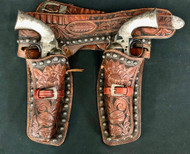Collector's Corner What do Colt Collectors Look For?
Posted by Jim Olson on Mar 5th 2023
The most iconic and collectible firearms in history have arguably been Colt pistols. Samuel Colt made his first firearm in 1836 and a long-lasting legacy was born. A famous saying from the 1800s was, “God made all men, but Sam Colt made all men equal.”
The Colt Single Action Army (AKA the Colt SAA, manufactured 1873 to present) is an obvious standout in the field, but pretty much any old Colt is desirable somewhere in the collector world. There are hundreds of different models and versions to go after. But no matter which version you are focusing on, savvy collectors tend to put value on certain things. Here are the top 5 things to consider when valuing a collectible firearm.
First would be rarity and popularity. It takes a combination of both because not all rare models are popular—and not all popular models are rare. An example of a rare and desirable handgun would be the Colt Walker Revolver. These were made in 1847 and only about 1100 of them were ever made. To this date, the most expensive firearm sold was a Colt Walker which brought 1.8 million at auction (even a worn out one can bring 50k or more). On the other hand, there were also only about 1000 of the Model 1855 Colt Revolving Rifles ever made, but they do not command anywhere near the price of a Colt Walker—they are just not as desirable to collectors. When collecting for investment, savvy collectors search out rarity, while keeping in mind desirability at the same time.
Next would be condition. There is a saying which goes, “condition is everything.” This is especially true when dealing with older and collectible items. Old Colts that remain in good condition are highly desirable. A few things to consider which can affect a condition score are: Is it original or has it been restored or tampered with? If original, how much finish is left? Is it mechanically sound and tight? In the “Blue Book of Gun Values” an early black powder model 1873 Colt SAA (under serial number 22,000) in excellent condition books at $35,000 while one in poor condition is worth only a couple thousand dollars. As you can see, condition makes a huge difference in value.
Special or unique features would be another thing to look for. Is it engraved or does it have special grips? If so, by whom? Were they ordered by the factory or done at their direction? If aftermarket, is it period correct? Or modern aftermarket? Does it have a barrel address that was only used for a short period of time or during a transition with the company (such as a London barrel address on an 1849 pocket or 1851 Navy model)? Or was it inspected by a certain inspector (such as a Colt SAA with an Ainsworth inspection mark)? Or shipped to a certain person or place? There are many little nuances which can mean hundreds or even thousands of dollars worth of difference.
Historical significance is another factor which also plays a part in a firearm’s value. The Colt SAA is iconic because of its place in history. Even though there were hundreds of thousands of them made over the years and they are not all that rare, they are still very desirable to collectors because of their place in history. A model 1911 is another example of a gun that was mass produced for a very long time, but they sell well because of their significance and the early ones can be highly desirable to collectors. Also a weapon tied to a specific historical character or event is generally highly desirable. History pays.
The last thing we will consider here is price. If “condition is everything,” then price is the most important thing (often the deciding factor). There are hundreds, even thousands of dollars worth of difference from firearm to firearm based on some of the facts mentioned above. So in order for a firearm to be highly collectible and demand a big price, it has to be “right” in every way. On the other hand, a lesser quality gun can become more attractive if it has a lower price point that makes it seem like a bargain. Most savvy collectors however will tell you to buy the best you can afford and work on trading up from there. So don’t just “price shop,” take the other factors listed above into consideration as well.
A parting thought to consider is authenticity. There are a lot of guns that just aren’t “right” and even some outright fakes out there. This is especially true when it comes to items costing several thousands of dollars or more. There are people who can take an old worn out gun and make it look practically new again. Serial numbers are often re-stamped and exaggerated stories are told like they are solid provenance—all in the hopes of moving a lower-end gun into the higher-end price category. So get an education before purchasing and be sure to deal with a reputable dealer. Remember, the “sting” of paying $10k for what should have been a $1k gun really hurts.
Happy collecting!
Jim Olson © 2021

